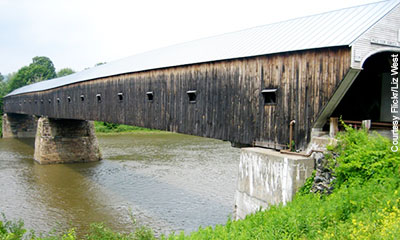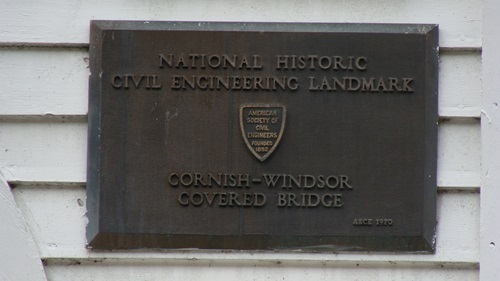Cornish-Windsor Covered Bridge
43 28 25.3 N, 72 23 02.1 W

The Cornish-Windsor Covered Bridge, a two-span covered bridge with an overall length of 460 feet, is the longest covered bridge existing in the United States.
"(W)e got about as far as the center of the western span when the bridge floor began to tremble strongly in keeping with the footfalls of a driving horse approaching us in the other span .... This was my only encounter with the sympathetic vibration once so destructive to the joints of bridges."
- Edwin A. Battison, Curator of Civil Engineering, Smithsonian Institution, 1970
The Cornish-Windsor Covered Bridge is the longest wooden bridge in the United States and the longest two-span, covered bridge in the world. It is also a classic example of wooden bridge-building in 19th-century America. With copious supplies of timber at hand and a generous reserve of carpentry skills available, bridge builders in early America quickly discarded the masonry arches prevalent in the Old World. Instead, they opted for a revival of timber-truss designs dating from 14th century Europe.
Based on a design patented by architect Ithiel Town in 1820, the Cornish-Windsor Bridge represents the first major step in the evolution of American wooden bridges. With load-bearing joints fastened together by wooden pegs, Town's design uses a lattice pattern that allows the load of the bridge to be distributed more evenly. Extending 460 feet across the Connecticut River and in regular use today, the Cornish-Windsor bridge continues to stand as a model of the economy and resilience of early American design.
Facts
- Constructed originally as a toll bridge at a cost of $9,000, the Cornish-Windsor Covered Bridge was purchased by the state of New Hampshire in 1936 and made toll-free in 1943
- The first structure crossing the Connecticut River at the site of the Cornish-Windsor Covered Bridge was built in 1796 and destroyed by flood in 1824. Subsequent bridges were built in 1824 and 1849, each built higher than the last, and each washed away by flood waters.
- Bridges based on Town's design could be assembled off-site by carpenters of modest skill and were widely popular. Town charged builders $1 per linear foot for use of his design -- and $2 per foot for pirated projects discovered by his agents!
- When Town first published a description of his patented lattice truss in 1821, he considered the possibility of using iron, rather than wood, to build it. No iron lattice-truss bridge was built, however, until 1859.
- Approximately 10,000 covered bridges existed in the U.S. at the turn of the 20th century. Of surviving examples, the Blenheim Covered Bridge in upstate New York and the Bridgeport Covered Bridge in Nevada County, California, are also considered prime instances of timber-truss design.
- The longest bridge using Ithiel Town's lattice-truss design -- with nine spans covering 2,820 feet -- was built over the James River at Richmond, Virginia, in 1838. It was destroyed by Confederate forces in 1865.
Resources
- Richard S. Allen, Rare Old Covered Bridges of Windsor County; Brattleboro, VT: The Stephen Greene Press, 1962.


